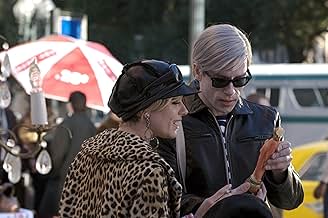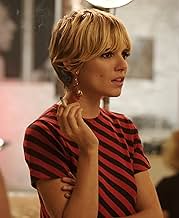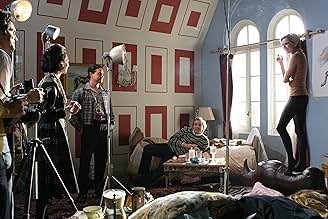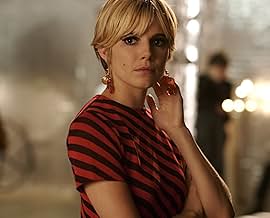Ajouter une intrigue dans votre langueBased on the rise and fall of socialite Edie Sedgwick, concentrating on her relationships with Andy Warhol and a folk singer.Based on the rise and fall of socialite Edie Sedgwick, concentrating on her relationships with Andy Warhol and a folk singer.Based on the rise and fall of socialite Edie Sedgwick, concentrating on her relationships with Andy Warhol and a folk singer.
- Réalisation
- Scénario
- Casting principal
- Récompenses
- 1 nomination au total
Avis à la une
Guy Pearce delivers a very acceptable performance. Hayden Christensen, playing a fictional character so obviously meant to be Bob Dylan, is ludicrously weak, having none of the self-containment and gravitas of a great musician and poet, even a young one. Sienna Miller is a revelation, and worthier of a much better film than this one, which is flawed by poor conceptualisation. Even before it was completed, Factory Girl alienates the people who could have helped to make it great.
Some of the Factory denizens who bought into and eventually shared Warhol's artistic vision became products of his genius in a conscious way. They achieved independence and recognition in their own right. People like Paul Morrissey, the Velvet Underground (including Lou Reed, John Cale, and Nico). Edie Sedgwick, sadly, lost sight of the artist within her and never quite made it. She wanted to be famous - Warhol gave her that. She would have needed her own creative diligence to consciously realise what made her a star and so become autonomously successful.
To be fair to the film, the complaints, lawsuits and criticisms of the likes of Lou Reed and Bob Dylan seem without substance. The film does not blame Warhol or Dylan for Sedgwick's demise. The panda-eyed, drug-abusing wash-out that is the Sedgwick nearer the end of the movie does, but the audience can hardly say anything except she brought about her own downfall: she ingratiated herself to Warhol and his world when she was a nobody without even a job, then moaned that she couldn't work when he dumped her, when in fact she was obviously unemployable because of her drug habit.
The film's only real crime is perhaps that it celebrates the life of Edie rather than Andy, and that not particularly well. Seeing her at her height through the eyes of Andy Warhol would have achieved much more. Both 'sides' of the bitter split between the two of them agree she had, at one point, remarkable presence, charisma, and on screen talent. An occasionally more Warholian approach to the cinematography, while keeping the film accessible, could have emphasised such qualities with self-conscious camera-work and other devices. Instead, we have determinedly Hollywood-style continuity-editing. Warhol devices such as split-screen are used for window dressing rather than any discernible emotional impact. Similarly, variations in film stock pay lip service to a Warhol vibe rather than building an awareness of Edie's inner persona.
Warhol was not only the most famous exponent of Pop art, but one of the most important exponents of New American Cinema. His techniques influenced both Hollywood and experimental film, and his style affected censorship laws and developed the 'camp aesthetic' (defined by Susan Sontag as, "the love of the exaggerated, the 'off', of things being what they are not"). Factory Girl capitalises on the name, but is mainstream through and through.
If the producers had worked with people of real vision; if they had secured song rights for music by Velvet Underground and Bob Dylan (which would have helped establish historical and cultural context); if they had portrayed the beauty and sparkle of Edie Sedgwick through the eyes and genius of Warhol or someone like him; if they had made insightful recognition of her weakness and her greatness, then this could have been a work of art. For Warhol and Dylan enthusiasts it is full of Campbell's Soup Cans and shots reminiscent of album covers - but without depth. Some will see a slightly offensive depiction of Warhol as a bloodsucker (he didn't pay the experimental artists who gathered in his studio or appeared in his films). For more casual viewers it is a slightly poignant story of the rise and fall of a quintessential American IT girl in a Pop Art universe bursting with sex, drugs, art and rock 'n' roll. Factory Girl is Hollywood factory rather than Warhol Factory. But should it be decried because of that?
While we do spend a good portion of the film in The Factory, this is more the tragic story of Edie, rather than an insightful look at Warhol's art. Edie was really the first to make being famous a job ... think Paris Hilton today. No real talent herself, her name, family money and looks got her inside the art world and exceptionally close to Warhol. Of course, those things were not enough to carve out any real territory and the ending, while tragic, is not at all surprising.
The film is overly choppy in attempting to find the right look and feel and yet with Jagger, Velvet Underground and the Dylanesque Hayden Christensen, the importance and power of music for this era is clearly established. Aussie Guy Pearce does a nice impersonation of Warhol and Jimmy Fallon has his first serious role. Other support comes from Mena Suvari as Edie's friend, Beth Grant as Warhol's mom, Don Novello (Father Guido from early SNL), and Illeana Douglas as Diana Vreeland.
By far the best part of this project is the performance of Sienna Miller as Edie Sedgwick. Even her vocal cadence is remarkable. The physical and emotional turmoil seems very real as Edie goes from top of world to desperation for life. Ms. Miller will at some point break out and become the film star she is destined to become. That role has just not quite happened yet. It could be later this year when she re-teams with her "Layer Cake" director. Let's hope so. Her talent is undeniable and although it is a pleasure to see her performance as Edie, she deserves a much wider audience.
The weakness of the film is best shown by the interviews over the closing credits. Attempting to explain what we had just watched is a pure indication that the job had not been done well.
Did Hickenlooper paint Edie as a perpetual victim (notice how throughout the film she is never injecting herself but is bent over while others inject her?) just so that he could show her as a victim of Andy Warhol and his drug fiend factory friends? Or that she was always a victim of people like her friend Chuck who did a complete turn on her for that villain Andy? Is Hickenlooper trying to say that the biggest mistake of Edie's life was not choosing Dylan over Warhol in that elevator scene where her future self voices over, "that was the biggest mistake of my life"? Edie Sedgwick came to the factory a sick person, she was already headed for a crash even before she set eyes on Andy Warhol. In reality, she was rejected by the factory friends and many others for the drugs she brought with her everywhere, she was not introduced to them at the factory as the movie shows.
Hickenlooper seems to me to be trying to say that Edie Sedgwick, that fresh faced wasp in knee socks and pearls who left Cambridge with sketches tucked under her arms could have potentially had a wonderful and peaceful life, even a stable marriage with Bob Dylan had she only not met Andy Warhol and been subject of those movies.
I have a problem with this film because I am so interested, most people are, in the real Edie Sedgwick and I agree with another poster who suggested you see Ciao!Manhattan to get a better sense of who she was. If you want a tragic love-story about a good girl who chose the wrong guy, watch Factory Girl.
The real Edie Sedgwick was a person whose hystrionics and drugs were symptoms of a soul that was always trying to fly away, for her the world was always too small and her pain was always too big, and she lived her life as though she dreamed of having her wings singed flying too close to the sun.
Just in case you read some of the rather hysterical comments and garner the impression that it's supposed to be about real people, it's not. Andy Warhol was never a real person, just a performance.
Guy Pearce presents Andy Warhol as the superficial creature he undoubtedly was. The original art-as-business creator, the very God at whose altar such modern day charlatans as Damien Hirst worship. Pearce's performance is riveting, his Andy Warhol is as empty as his crapulous art; just a two-dimensional diagram of someone who leaves no shadow. A cartoon.
Sienna Miller's performance as Edie Sedgewick is the best thing she's ever done. Caught in the strobe lights of Warhol's strangely sterile world of non-sexual sex and sofas still in their plastic wrappers, Edie becomes the focus of his short attention span for a while. She flashes across the screen like a speeded up Holly Golighty, while Warhol's voyeuristic viewfinder traps her in it's leering stare. The camera loves her and so does Warhol. But we know it's going to end in tears.
Nothing in the movie has much depth, none of the characters are developed beyond what we already know about them and the whole sixties New York scene is represented by a series of iconic "things". The Chelsea Hotel, the Velvet Underground, a soundtrack of songs that sound right but which actually don't fit at all. For instance, "Leavin' here" by The Birds, a British group in which Ronnie Wood was the guitarist, was recorded in 1966 but was never released in America. However, there it is on the soundtrack being played in the factory sometime in 1965.
But no matter.
The movie pretty much captures the shallow, transient and utterly facile world of Warhol in the sixties and in another way it sums up the emptiness and tragedy of the Hollywood dream machine too. But it doesn't ask any deep questions nor does it pretend to be something it's not. It's entertaining and worth watching for two very good performances by Guy Pearce and Sienna Miller.
It's not art, it's just a movie, albeit a superficial one.
Okay, let me say that I enjoyed Factory Girl for what it is and think it is worth renting.
The story stars Sienna Miller as the fated Edie Sedgwick and Guy Pearace as vapid pop culture icon, Andy Warhol.
The movie isn't nearly as close to as bad as critics claim it is. The first 40 minutes is much ado about talk of cocks, Andy and Edie's irreverence, and a series of disjointed images. The first act is aimless. But it makes sense because Edie and Andy are aimless and so are the termites chewing Andy's wood at "The Factory".
Enter Hayden Christensen as Billy Quinn and the movie develops its paper thin plot. Though, I should say it's unfair to characterize the story this way. Edie's life was a paper thin plot, so the director, Hickenlooper can't be blamed for that.
Andy, who never says he is gay, though everyone else assumes (or knows) he is, is in love with the idea of Edie "The Superstar" and Billy Quinn simply wants to open her eyes. She becomes the rope in a tug of war. Billy's "soul" cries for the world in a time of upheaval versus the-devil-may-care, drug den world of Andy. And while the latter may be in "love" with his muse, Billy cares and wants Edie to know, if art is the food of the soul, then Edie is eating from an empty soup can.
Edie is a sympathetic character. You get the sense that no one really knew her. Not because she was empty and vapid but that she was so shattered inside the only part of herself she allowed the world to see was the facade her Andy created. In Factory Girl we see Edie through the looking glass. Not as she was, but as she appeared. Warped.
Edie is the cute girl you meet in passing at a party at some stranger's house. You like her, but never see her again. Though, over the years you hear the occasional rumor or two, until one day, you hear she's hit rock bottom and died. That's how it feels to watch Edie Sedgewick's story in The Factory Girl. On one hand, you want to mourn her. On the other hand, you wonder, what has the world lost? That in itself is the real tragedy.
Le saviez-vous
- AnecdotesSienna Miller improvised the scene in which Edie tells The Musician about her brothers' deaths.
- GaffesEdie Sedgwick's relationship to Nico is depicted incorrectly: in reality they were friends and Edie warned Nico about Andy Warhol's behavior. Edie's death was very sad for Nico.
- Citations
Andy Warhol: I wonder if people are going to remember us?
Edie Sedgwick: What, when we're dead?
Andy Warhol: Yeah.
Edie Sedgwick: Well, I think people will talk about how you changed the world.
Andy Warhol: I wonder what they'll say about you... in your obituary. I like that word.
Edie Sedgwick: Nothing nice, I don't think.
Andy Warhol: No no, come on. They'd say, "Edith Minturn Sedgwick: beautiful artist and actress...
Edie Sedgwick: ...and all-around loon.
Andy Warhol: ...Remembered for setting the world on fire...
Edie Sedgwick: ...and escaping the clutches of her terrifying family...
Andy Warhol: ...Made friends with eeeeverybody and anybody...
Edie Sedgwick: ...creating chaos and uproar wherever she went. Divorced as many times as she married, she leaves only good wishes behind.
[laughs]
Edie Sedgwick: That's nice, isn't it?
- Crédits fousDuring the first part of the end credits, photos are shown of the real Edie Sedgwick. Also people who knew her give testimonies about her.
- Versions alternativesAccording to the FAQ section: "For the home theatre market, an unrated version was released aside from the R-rated theatrical version. Most scenes which were re-inserted or alternately shifted, serve to specify character drawings and various aspects of the story which were only embedded in the theatrical version to some extent. However, there are also a few extensions with sexual contents and more explicit depictions of drug use."
- Bandes originalesDino's Song
Written by Chet Powers (uncredited)
Performed by Quicksilver Messenger Service
Courtesy of Capitol Records
Under License from EMI Film & Television Music
Meilleurs choix
Détails
- Date de sortie
- Pays d’origine
- Langues
- Aussi connu sous le nom de
- Fábrica de sueños
- Lieux de tournage
- Sociétés de production
- Voir plus de crédits d'entreprise sur IMDbPro
Box-office
- Budget
- 7 000 000 $US (estimé)
- Montant brut aux États-Unis et au Canada
- 1 675 241 $US
- Montant brut mondial
- 3 572 632 $US
- Durée1 heure 40 minutes
- Couleur
- Mixage
- Rapport de forme
- 1.85 : 1
Contribuer à cette page






































